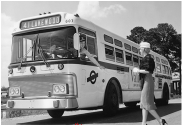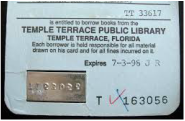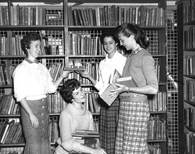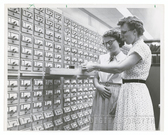
Visiting the public library for our family involved an hour bus ride from the suburbs, across the St. John's River, to downtown. There were no branch libraries at the time. Our only other libraries were at the public school and a few religious books at church. The library was our first stop in a whole Saturday's activities of shopping, hair appointments, lunch, and maybe a movie.

The Jacksonville, FL library was a Neo-Classic Revival design of Henry John Klutho built in 1905 and partially funded by Andrew Carnegie. It is now on the National Register of Historical Places and is used as law offices. The limestone and copper structure is said to be almost fireproof, an important consideration at the time after a massive fire in 1901 destroyed over 2,300 downtown buildings.

Three things stand out in my memory about the library. One was my own, personal library card. The small square of manila-folder type paper had a metal strip inbedded in the corner with my number, used for impressing at check out.
(this is NOT my card, but similar.)

Secondly, there was a special collection of rare books, mostly about Florida, in an upstairs section that could be seen from the main floor. When I say seen, I mean that literally. The floor was of wire mesh, like the wall of this interior photo. I recall thinking the area was like a jail, with a special latched and guarded door. You could walk on the level underneath the wire room and look up to see the people browsing above. It was a puzzle as to why the floor was see-through, when at this era women wore skirts or dresses, not slacks, making it possible to look up and get an eyeful of embarrassing views. Women also wore spiked heels that would get caught in the mesh holes, so they usually tip-toed. This supplemented the "all quiet" library atmosphere.
The third memory is of the children's section with fascinating miniature displays and dioramas in a large glass hutch. If we were able to arrive early on Saturday mornings I could attend the children's story time led by the Librarian. I wasn't a fanatical reader, but at this spacious library I was allowed to explore on my own and check out my own books. The Borrowers was a favorite. My mother was an elementary school teacher and an avid reader, so we went to the library rather often.
The third memory is of the children's section with fascinating miniature displays and dioramas in a large glass hutch. If we were able to arrive early on Saturday mornings I could attend the children's story time led by the Librarian. I wasn't a fanatical reader, but at this spacious library I was allowed to explore on my own and check out my own books. The Borrowers was a favorite. My mother was an elementary school teacher and an avid reader, so we went to the library rather often.

Finding a specific book was more difficult back then. We had to search for the shelf location using the old card catalog system. A series of drawers full of hand typed cards, one for each book, was filed in the wooden cabinets. Often you had to wait your turn to get to the right drawer - a challenge for a little kid.

You had to hope no one had removed a card...because maybe they were too lazy to copy down the call numbers? If the card wasn't in the catalog drawer, you had no way of knowing if the library had a copy, or where to find it. And, just because there was a card in there didn't mean the book was really on the shelf. Without computers, it must have been terrifically difficult to keep up with the inventory.
There were fines for being late, but I don't recall ever receiving letters or phone calls to tell us about a late or missing book.
Our suburban library branch was not built until 1973, well after I had graduated from high school. Speaking of branches, my current city recently opened the first all digital public library in the United States - NO books at all, just full of computers. My, how things have changed!
There were fines for being late, but I don't recall ever receiving letters or phone calls to tell us about a late or missing book.
Our suburban library branch was not built until 1973, well after I had graduated from high school. Speaking of branches, my current city recently opened the first all digital public library in the United States - NO books at all, just full of computers. My, how things have changed!
 RSS Feed
RSS Feed
